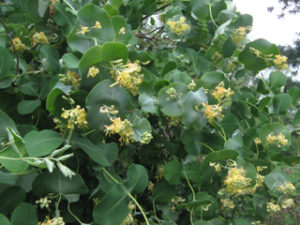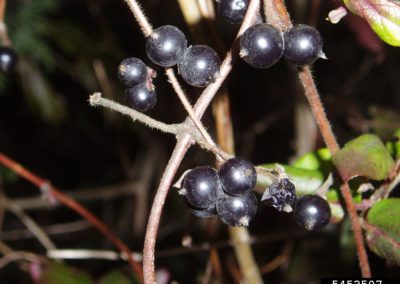Japanese Honeysuckle (Lonicera japonica)
Invasive Management Profile
Japanese Honeysuckle is a rapid growing invasive species in Indiana. If you find one Japanese Honeysuckle, chances are you will find many more invading an area. This invasive plant is known for its beautiful fragrant flowers and rapid growth. Although it smells good, this plant will overtake an entire area and drown out native species.
Identification
Japanese Honeysuckle is a woody vine, which means it has hard woody stems and will usually survive above ground throughout the winter. If broken off, the stems will feel woody and hollow. The leaves are an oval shape and hairy, usually 1-3 inches long. Japanese Honeysuckle is easy to identify by its unique flowers. Usually white and turning yellow with age, the flower blooms in the late spring and early summer. The flowers can be found in pairs. Black berries appear in the fall.
Tools & Supplies Needed
- Shovel and/or spade
- Handsaw and/or lopper
- Protective eyewear, gloves, and clothing
- Paper or plastic bags for disposal
Removal Methods
STEP 1 : Identify plant using our identification tips and photos as well as the time of year and growth stage.
STEP 2 : Wear protective eyewear, gloves, and clothing.
STEP 3 : Use your hand to grab the bottom of the plant, twist, and pull.
STEP 4 : When pulling, make sure to remove the taproot, which is the main root system (this may be easily removed with a spade or shovel as well).
STEP 5 : Make sure to place all plant debris into a plastic or paper bag to control seed spread.
STEP 1 : Identify plant using our identification tips and photos as well as the time of year and growth stage.
STEP 2 : Wear protective eyewear, gloves and clothing.
STEP 3 : Using an axe or chainsaw cut the tree 5-10 inches from the ground. Be aware of your surroundings and always wear protection when using this equipment.
STEP 4 : Treat with herbicide or remove root system. For removal of the root system, start digging 3 feet away from the base of the stump.
STEP 6 : Once you can see the majority of the rootball, slide your shovel under it and gently begin loosening and prying it up, away from the ground.
STEP 7 : Once the rootball is free place it and all clippings on a tarp to stop the spreading of seeds or regrowth.
Disposal
For disposal of Japanese Honeysuckle, package the plant waste in a large plastic or paper bag for landfill.
Native Alternative Species
To learn more about natives and how to landscape with them click here.
Grape Honeysuckle (Lonicera reticulata)
|
Growth Type: woody vine
Height: 10 to 15 feet
Spread: 10 to 15 feet
Bloom Time & Description: May; showy pale yellow or orange-yellow flower
Fruit: Showy, orange-red
Light exposure: Part shade
Attracts: Birds, Butterflies, hummingbirds
|
 Photo Courtesy of INPAWS Photo Courtesy of INPAWS |
Coral honeysuckle (Lonicera sempervirens)
|
Growth Type: Woody vine
Height: 8 to 15 feet
Spread: 3 to 6 feet
Bloom Time & Description: May to June; showy scarlet/orange flower with yellow inside
Fruit: Showy
Light exposure: Full sun
Attracts: Birds, Butterflies, Hummingbirds
Tolerate: Deer, Clay Soil, Black Walnut
|
Need Photo |




